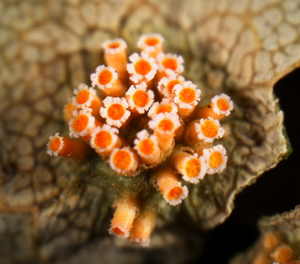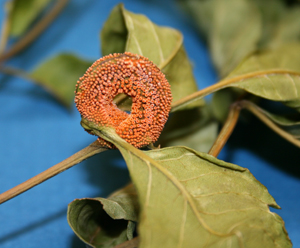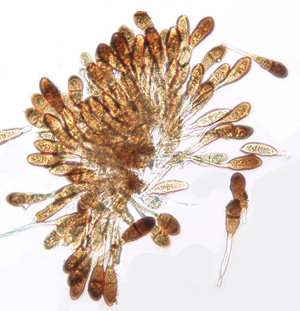G1942
Ash Rust
Ash rust can disfigure or prematurely defoliate ash trees. This NebGuide discusses ash rust symptoms, disease cycle and management.
Amy Ziems, Extension Educator, Plant Pathology
Ash rust is distributed throughout most of eastern North America and can be seen in Nebraska sporadically. It is caused by the fungus Puccinia sparganioides, and can infect several species of ash (Fraxinus) including green, white, and black.
The alternate hosts for this rust include several species of cordgrass (Spartina spp.) and a marsh grass (Distichlis spicata). This disease is more prevalent and severe in areas where the alternate hosts (cordgrass species and marsh grass) are most abundant, such as wet or saline soils.
Symptoms
Ash rust is commonly found on leaves, though infection can occur on all the current year’s growth. Initial symptoms are yellow to orange spots on the upper leaf surface and chlorotic spots on twigs and petioles. Approximately two weeks following infection, bright orange lesions (1/6 to 1/2 inch diameter) appear on petioles, stems, and on the lower side of the leaf (Figure 1).
These lesions contain two spore types. Spermatiospores or pycniospores appear first but they generally are not noticed. Then aeciospores become visible (Figure 2). Diseased tissue may swell, causing distortion of leaves, sharp bends in the petioles (Figure 3) and roughly egg-shaped galls on twigs and seeds.
If infections are severe, premature defoliation of the tree will occur. Trees with severe infection can also suffer deformation or death of the current year’s shoot. If that shoot is a leader, its death can result in a multi-stemmed tree.
There are no other rusts that affect ash; however there are several rust species that infect cordgrass. The rust species that infect cordgrass are difficult to distinguish. It is important to note that the presence of rust on cordgrass does not necessarily mean ash trees in these surrounding areas are threatened. Rusts observed on cordgrass include Puccinia distichlidis, P. seymouriana, and Uromyces acuminatus. Alternate hosts of P. distichlidis include fringed loosestrife (Lysimachia ciliate) and milkwort (Glaux maritima). Alternate hosts for P. seymourina include buttonbush (Cephalanthus sp.), dogbane (Apocynum sp.), and milkweed (Ascelpias sp.).
 |
 |
|
| Figure 1. Leaves of ash infected with ash rust. The orange structures on the lower surface of leaves are the aecial cups in lesions. | Figure 2. Closeup of distinctive pycnida and aecial “cluster” cups with orange-yellow aeciospores proliferating from the surface of infected tissue (10x magnification). | |
 |
 |
|
| Figure 3. Ash leaf rachis (leaf stem) distorted by ash rust. | Figure 4. 200x magnification of teliospores produced on cordgrass. |
Disease Cycle
Puccina sparganioides survives the winter on cordgrass and marsh grass in structures called telia. This fungus does not overwinter on ash. During warm, wet springs the teliospores (Figure 4) within the telia will germinate to produce basidiospores. Ash trees become infected when moist air moves the basidiospores onto wet leaves, petioles, and green shoots where these spores germinate and infect the plant tissue.
As the fungus develops in the ash tissue, it produces spore-producing structures called spermagonia or pycnia in the yellow spots on the upper leaf surface and on chlorotic spots on petioles and stems. The bright orange lesions containing aeciospores (Figure 2) appear on the lower leaf surface, petioles and stems approximately two weeks after the spermagonia appear
Management
Typically, ash rust disfigures and defoliates trees but does not seriously threaten the health of the tree. Repeated ash rust infections can weaken trees, especially those grown near wetlands where cordgrass and marsh grass grow. Weakened trees are more susceptible to winter damage and winter dieback. If the leader of a small tree dies from infection, the tree should be pruned the following year to train the stem to a single leader. Prune in late February or early March when the tree is still dormant and prior to the active growth.
Valuable trees can be protected from severe infections with timely fungicide treatments (Table I). During wet springs, begin the fungicide applications as the buds break open and repeat according to label instructions until the foliage is fully developed. The use of fungicides that have systemic properties (i.e. thiophanate-methyl) will have longer residual periods, thus fewer reapplications will be required.
| Table I. Fungicidesa available for Ash Rust | ||
| Fungicide Active Ingredient | Trade Name | Commercial (C)/
Homeowner (H) Use |
| Bayleton | Bayleton 50 WSP Turf and Ornamental Fungicide in Water Soluble Packets (Bayer) | C |
| Strike 50 WDG (OHP Inc) | C |
|
| Chlorothalonil | Chlorothalonil 500 ZN (Quali-Pro) | C |
| Chlorothalonil 720 (Arysta LifeScience) | C |
|
| Daconil Ultrex Turf Care (Syngenta) | C |
|
| Echo Ultimate Turf and Ornamental Fungicide (Sipcam Agro USA) | C |
|
| Ensing 82.5% Turf and Ornamental Fungicide (Loveland Products Inc) | C |
|
| Mainsail 6.0 F (Prokoz Inc) | C |
|
| Ortho MAX Garden Disease Control (Ortho Company) | H |
|
| Pegasus DF (Phoenix Environmental Care LLC) | C |
|
| ProSolutions Thalonil 6L (Agrilliance LLC) | C |
|
| Chlorothalonil + Propiconazole | Concert (Syngenta) | C |
| Chlorothalonil + Thiophanate-methyl | TM + CTN E-Pro 90 WDG Fungicide (Etigra) | C |
| Myclobutanil | Eagle 20 EW (Dow AgroSciences) | C |
| Hoist (Prokoz Inc) | C |
|
| Propiconazole | Banner Maxx (Syngenta) | C |
| Bonide Fung-Onil Lawn and Garden Disease Control RTS (Bonide Products Inc.) | H |
|
| Fathom 14.3 MEC Fungicide (Prokoz Inc) | C |
|
| Ferti-lome Systemic Fungicide (Voluntary Purchasing Groups Inc) | H |
|
| Kestrel ( Phoenix Environmental Care LLC) | C |
|
| Procon-Z Fungicide (Loveland Products Inc) | C |
|
| ProPensity (Sipcam Agro USA) | C |
|
| Thiophanate-methyl | OHP 6672 4.5 F (OHP Inc) | C |
| OHP 6672 50 WP (OHP Inc) | C |
|
| T-Methyl E-Pro 4.5 Fungicide (Etigra) | C |
|
| Transom 4.5 F (Prokoz Inc) | C |
|
| aThis list is presented for information only and no endorsement is intended for products listed nor criticism meant for products not listed. Consult the product label for specific application rates. Read the label carefully before making any application. | ||
This publication has been peer reviewed.
Disclaimer Reference to commercial products or trade names is made with the understanding that no discrimination is intended of those not mentioned and no endorsement by University of Nebraska–Lincoln Extension is implied for those mentioned. |
Visit the University of Nebraska–Lincoln Extension Publications Web site for more publications.
Index: Plant Diseases
Trees
Issued April 2009